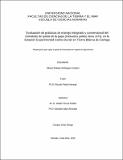| dc.contributor.advisor | Piedra Naranjo, Ricardo | |
| dc.contributor.author | Rodríguez Cordero, Álvaro Esteban | |
| dc.date.accessioned | 2020-09-15T01:06:19Z | |
| dc.date.available | 2020-09-15T01:06:19Z | |
| dc.date.issued | 2019 | |
| dc.identifier.uri | http://hdl.handle.net/11056/18153 | |
| dc.description | Trabajo final de graduación para optar al grado de Licenciado en Ingeniería Agronómica | es_ES |
| dc.description.abstract | El género Globodera, comúnmente llamado nematodo quiste de la papa, es una de las principales plagas del cultivo de la papa a nivel mundial y en Costa Rica no es la excepción. El objetivo general de este estudio fue comparar la densidad poblacional de Globodera pallida en parcelas infestadas naturalmente utilizando prácticas convencionales y prácticas de manejo integrado. El estudio se llevó a cabo en la Estación Experimental Carlos Durán, ubicada en Oreamuno de Cartago, durante los meses de octubre a diciembre de 2017. El diseño experimental utilizado fue de bloques completos al azar con tres repeticiones para cada tratamiento. Se contabilizó la cantidad de quistes, larvas y huevos por gramo de suelo para posteriormente determinar su viabilidad. Los datos generados se analizaron empleando un modelo lineal generalizado según el procedimiento Mixed en el software SAS® 9,4 y el rendimiento con una prueba t student. De acuerdo con los resultados, no se encontraron diferencias significativas entre el manejo convencional e integrado, lo que indicó un control semejante entre ambos tratamientos. Asimismo, no se encontraron diferencias en el rendimiento de los tratamientos. Por otra parte, los costos de producción fueron mayores en el manejo integrado por la alta aplicación del hongo Trichoderma sp. Bajo las condiciones experimentales no hubo diferencias estadísticamente significativas que indiquen que un manejo sea mejor o más efectivo que el otro, por lo cual el control de G. pallida en el cultivo de papa fue similar independientemente de si es integrado o químico. Es importante considerar que hay que disminuir o evitar el uso de químicos por las consecuencias negativas en el ambiente y la salud. | es_ES |
| dc.description.abstract | The genus Globodera, commonly called the potato cyst nematode, is one of the main pests of potato crops worldwide and in Costa Rica it is no exception. The general objective of this study was to compare the population density of Globodera pallida in naturally infested plots using conventional practices and integrated management practices. The study was carried out at the Carlos Durán Experimental Station, located in Oreamuno de Cartago, during the months of October to December 2017. The experimental design used was randomized complete blocks with three repetitions for each treatment. The amount of cysts, larvae and eggs per gram of soil was counted to later determine their viability. The data generated were analyzed using a generalized linear model according to the Mixed procedure in SAS® 9.4 software and the performance with a student t test. According to the results, no significant differences were found between conventional and integrated management, which indicated a similar control between both treatments. Likewise, no differences were found in the performance of the treatments. On the other hand, production costs were higher in integrated management due to the high application of the fungus Trichoderma sp. Under the experimental conditions, there were no statistically significant differences that indicate that one management is better or more effective than the other, so the control of G. pallida in the potato crop was similar regardless of whether it is integrated or chemical. It is important to consider that the use of chemicals must be reduced or avoided due to the negative consequences on the environment and health. | es_ES |
| dc.description.abstract | | es_ES |
| dc.description.sponsorship | Universidad Nacional, Costa Rica | es_ES |
| dc.language.iso | spa | es_ES |
| dc.publisher | Universidad Nacional, Costa Rica | es_ES |
| dc.rights | Acceso abierto | es_ES |
| dc.rights | Attribution-NonCommercial-NoDerivatives 4.0 Internacional | * |
| dc.rights.uri | http://creativecommons.org/licenses/by-nc-nd/4.0/ | * |
| dc.subject | NEMÁTODA | es_ES |
| dc.subject | CULTIVO | es_ES |
| dc.subject | PLANTAS | es_ES |
| dc.subject | MANEJO DE PLAGAS | es_ES |
| dc.subject | ABONOS ORGÁNICOS | es_ES |
| dc.subject | CROP | es_ES |
| dc.subject | PLANTS | es_ES |
| dc.subject | PEST MANAGEMENT | es_ES |
| dc.subject | ORGANIC FERTILIZERS | es_ES |
| dc.title | Evaluación de prácticas de manejo integrado y convencional del nematodo de quiste de la papa (Globodera pallido Stone 1973), en la Estación Experimental Carlos Durán en Tierra Blanca de Cartago | es_ES |
| dc.type | http://purl.org/coar/resource_type/c_7a1f | es_ES |
| una.tesis.numero | TESIS 10571 | es_ES |
| dc.description.procedence | Escuela de Ciencias Agrarias | es_ES |


